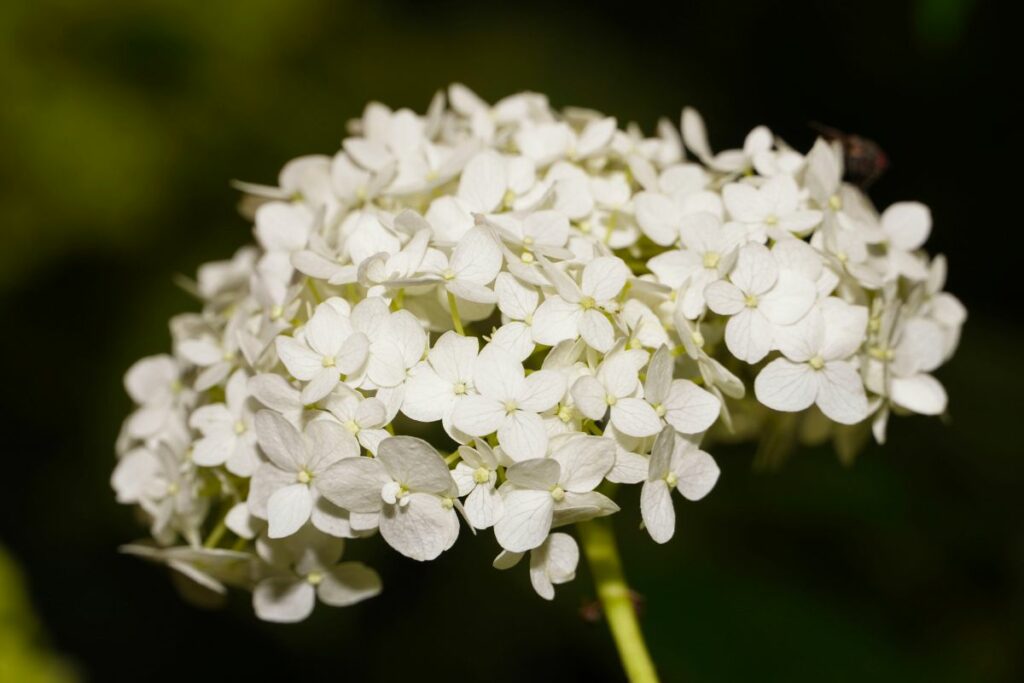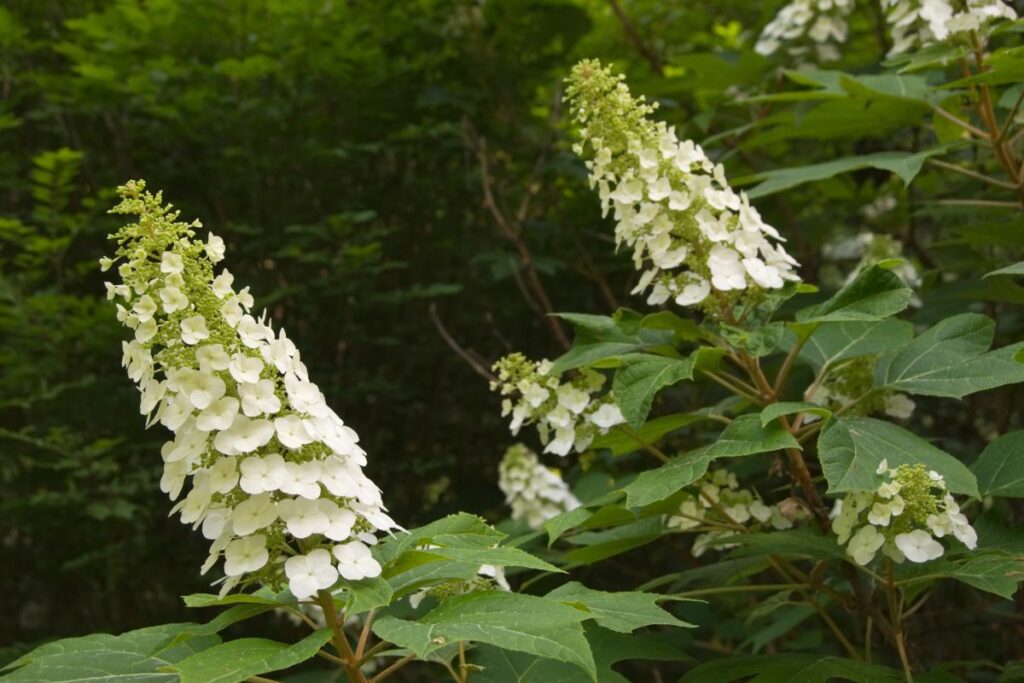Hydrangeas are a staple in many gardens, captivating onlookers with their full blooms and vivid hues. Found in numerous shapes and colors, these plants enhance outdoor spaces with their variety and beauty. Their allure has made them a favorite choice for garden enthusiasts worldwide, providing an array of options for every gardener’s preference.
In the United States, gardeners often cultivate six main types from over seventy-five known species of hydrangeas. Whether one desires large, showy flower heads or more modest, delicate clusters, hydrangeas offer a versatile selection to fit any gardening style and space.
1. Climbing Hydrangea
- Growth Habit: This vining plant thrives by adhering to surfaces with tiny roots, perfect for covering bare walls.
- Height Potential: With proper support, these plants can grow vines up to 30 feet.
- Shade Tolerance: Unlike many climbers, they grow well in less sunny spots.
- Hardiness Zones: Ideal for zones 4-9, they’re robust across many climates.
- Seasonal Appeal: The season begins with heart-shaped leaves, followed by white, aromatic flower clusters. As autumn arrives, leaves adopt a golden hue, and in winter, the stems reveal attractive cinnamon bark.
- Privacy Use: An excellent choice for creating a natural screen on balconies.
To enhance your garden’s vertical flair or to screen an unsightly view, consider the hardy climbing hydrangea. This plant not only brings lush foliage and fragrant blossoms but also adds year-round beauty with its seasonal transformations.
2. Smooth Hydrangea

- Blossom Size: Up to 8 inches in diameter
- Flower Arrangement: A mix of tiny core fertile flowers encircled by larger sterile ones
- Optimal Uses: Ideal for creating hedges and foundational landscapes
- Color Transformation: Starts as bright green, turns creamy white, and becomes tan in the fall
- Foliage: Broad, rich green leaves with distinctly serrated edges
Smooth hydrangeas, native to the eastern United States, are noteworthy for their vibrant and sizeable flower clusters, which contribute to a lush appearance perfect for garden borders. Initially emerging a vivid green, the blooms mature into their classic creamy white before assuming a tan shade in autumn.
Your garden can be enhanced by these plants; they are not only visually stunning but also resilient. They perform remarkably well across a wide range of hardiness zones—specifically from 3 to 9, indicating their versatility and adaptability to various climate conditions. They possess a high tolerance to heat, enduring prolonged dry spells with ease.
When planning your garden, consider positioning these hydrangeas in areas that provide some respite from the intense afternoon sun, particularly in warmer regions. This strategic placement helps in maintaining the vitality and longevity of the plants.
3. Panicle Hydrangea
Growth and Care:
- Sturdy development
- Minimal maintenance
- Thrives in cold conditions
Climate Adaptability:
- Ideal growth in zones 3 to 8
Summer Bloom:
- Begins midsummer
- Conical flower clusters
Seasonal Color Change:
- Flowers turn from white to pink in autumn
- Pink blooms age to brown in late season
Winter Appearance:
- Brown blossoms last through winter
Cultivation Variants:
- Some can be trained as tree forms
Popular Varieties:
- Notable type: Grandiflora
- PeeGee variety can grow up to 25 feet
4. Mountain Hydrangea
These hydrangeas showcase eye-catching blue or pink lacecap flowers. Ideally suited for compact spaces, these plants typically do not grow taller than 6 feet, making them a perfect match for small gardens or as border plants.
You’ll admire the rapid growth rate of these hydrangeas—they can add about 2 feet to their height annually given the right conditions.
These hydrangea variants require a temperate climate, as they struggle in areas colder than USDA zone 6.
To thrive, maintaining consistent soil moisture is crucial. Although they can endure some sun, they flourish in shaded areas.
While they may not share the same renown as their more famous counterparts, mountain hydrangeas offer stunning beauty with varieties such as ‘Preziosa’, ‘Bluebird’, and ‘Diadem’.
5. Oakleaf Hydrangea

When autumn arrives, the oak-like leaves of this shrub transition to stunning shades of burgundy, crimson, or orange, sure to make your garden a visual delight.
Winter brings its own charm. The plant sheds its leaves, revealing an attractive exfoliating texture on its bark, enhancing the garden’s appeal even during the coldest months.
Come spring, expect an outpouring of creamy white flowers that cluster into cone shapes. Watch as these blooms gradually infuse with pink tones as the season wanes.
Growing an oakleaf hydrangea is straightforward. Just ensure it’s planted in well-drained soil, and while it’s important to keep these shrubs out of the blazing afternoon sun, a location in permanent shade could diminish the vibrancy of their autumn leaves.
| Flowering Season | Flower Color Evolution | Light Conditions | Fall Foliage |
|---|---|---|---|
| Early | Creamy white to pink | Morning sun, avoid full sun & deep shade | Burgundy/Crimson/Orange |
For a garden that boasts year-round interest, the oakleaf hydrangea is a robust choice.
6. Bigleaf Hydrangeas
Flat Bloom Hydrangeas
Your garden aesthetic can be enhanced with the unique bloom pattern of these hydrangeas, presenting a ring of showy, unfertilised flowers encircling a core of rich, fertile florets. A varied flowering period can be achieved by growing multiple hydrangea species due to the color fading in these blooms within a month. Notable flat bloom hydrangeas include the striking ‘Lady in Red’, the bold ‘Zorro’, and the delicate ‘Lanarth White’.
Globe Flower Hydrangeas
These hydrangeas showcase stunning, spherical blooms that will captivate you all summer long. Blossoming can last from three to six months prior to dormancy in cooler temperatures. Be mindful of the winters, as the budding flowers are cold-sensitive. Varied in sizes, from the small ‘Masja’ to larger types like ‘Charm’ and the white blossoms of ‘Madame Emile Mouillere’, there’s a globe flower hydrangea to fit any garden space.
Selecting the Ideal Hydrangea Variety for Your Garden
Uncommon Hydrangea Species for Cultivation
When choosing a hydrangea for your garden, it’s essential to take into account several factors. Climatic conditions should guide your choice; panicle or smooth hydrangeas thrive well in colder areas. For those with limited garden space, mountain hydrangeas will be more appropriate due to their compact growth.
Your gardens’ color scheme is also a matter of personal taste. To enjoy vibrant colors through different seasons, bigleaf and mountain hydrangeas are superior choices.
All hydrangea types share a preference for partial shade and benefit from regular feeding, which will allow them to blossom profusely and grow robustly.
Consider experimenting with these less commonly known hydrangeas to add a touch of rarity to your space:
- Hydrangea aspera: These present broad, soft leaves and flower heads with a flat shape.
- Hydrangea involucrata: Their flowers are small, globe-shaped, and are set within dainty, lace-like bracts.
- Silver Dollar Hydrangea: Distinct for its silvery leaves and pure white blooms.
- Miranda: Offers uniquely variegated leaves bordered in cream or yellow, coupled with white lacecap flowers.
- Japanese Hydrangea Vine: Not as widespread as the climbing varieties, it will make your garden stand out.
Whichever hydrangea you choose, you can be assured of an enchanting display of blooms in your garden.


i planted my bush years ago I don’t know which one it is but it has only bloomed blue and pink flowers twice am I suppose to cut the dead looking flowers off ?